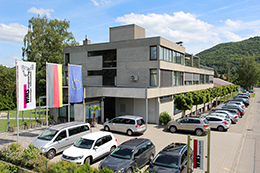|
 |
 |
 |
The future of robotics and automation depends
on humans and robots working together
In 2006, the world was at
the very beginning of the
smartphone revolution. At the
time we could only imagine
how this market would
develop. Many envisioned
a future which would bring
exploding demand for
affordable, miniaturized, mobile
electronics. |
|
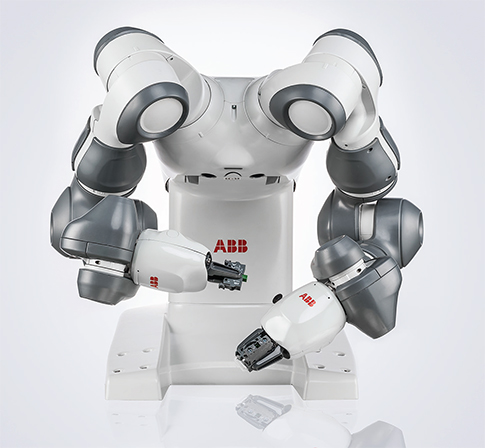
|
| |
|
|
That is why nearly a decade ago we began re-examining our
approach to robotics and automation, in general. In particular,
we focused on replacing complex and complicated processes
with flexible and agile systems. In time, these advancements
collectively came to be known as the Integrated Industry, or
the so-called fourth industrial revolution. Cyber-physical systems,
production scenarios and real man-machine-collaboration
are the keys to successfully managing the ecosystem of
people, things and services growing out of this revolution. In
addition this new kind of collaboration has to deliver balanced
solutions able to utilize this ecosystem’s greatest strengths in
a sustainable, efficient and profitable way.
Today, the market has turned into something beyond our
wildest expectations. It is more complex than we ever imagined
and requires an incomprehensibly vast system of manual
assembly. Millions of workers, across thousands of assembly
lines, build the electronics upon which the world has come
to depend. The explosive growth and extremely short life
cycles of these types of products, coupled with rising demand
for more rewarding jobs, higher pay and better quality of life
among workers, means that, ultimately, the current system is
neither scalable nor sustainable. |
|
Looking back to 2006, when we started developing the
concepts for a small parts assembly solution that addressed
these issues, we did not know just how great the need would
be. We understood that these manual assembly lines would
have to be automated — and that it would be a transition that
would likely take decades and would need to happen without
disruption to the complex, vast and deeply ingrained existing
small parts assembly infrastructure. As such, whatever solution
we developed would have to be robotic in nature, and it would
have to work safely next to humans. These days we call this
concept human-robot collaboration, but back then we were
simply thinking of it as creating an inherently safe solution.
We knew that this market required the flexibility to handle constantly
changing products that have life cycles on the order of
several months and shrinking. The solution needed to be easily
portable and re-deployable as well as able to fit into existing
workspaces designed for humans. It also needed to employ
innovative programming methods so intuitive to use anyone can
do it without special training. It had to have senses and motor
control comparable to humans. Above all, though, it needed to
be safe enough to work side-by-side with its human coworkers
without safety caging and without being threatening.
That vision is what ultimately led to YuMi®. |
| |
|
|
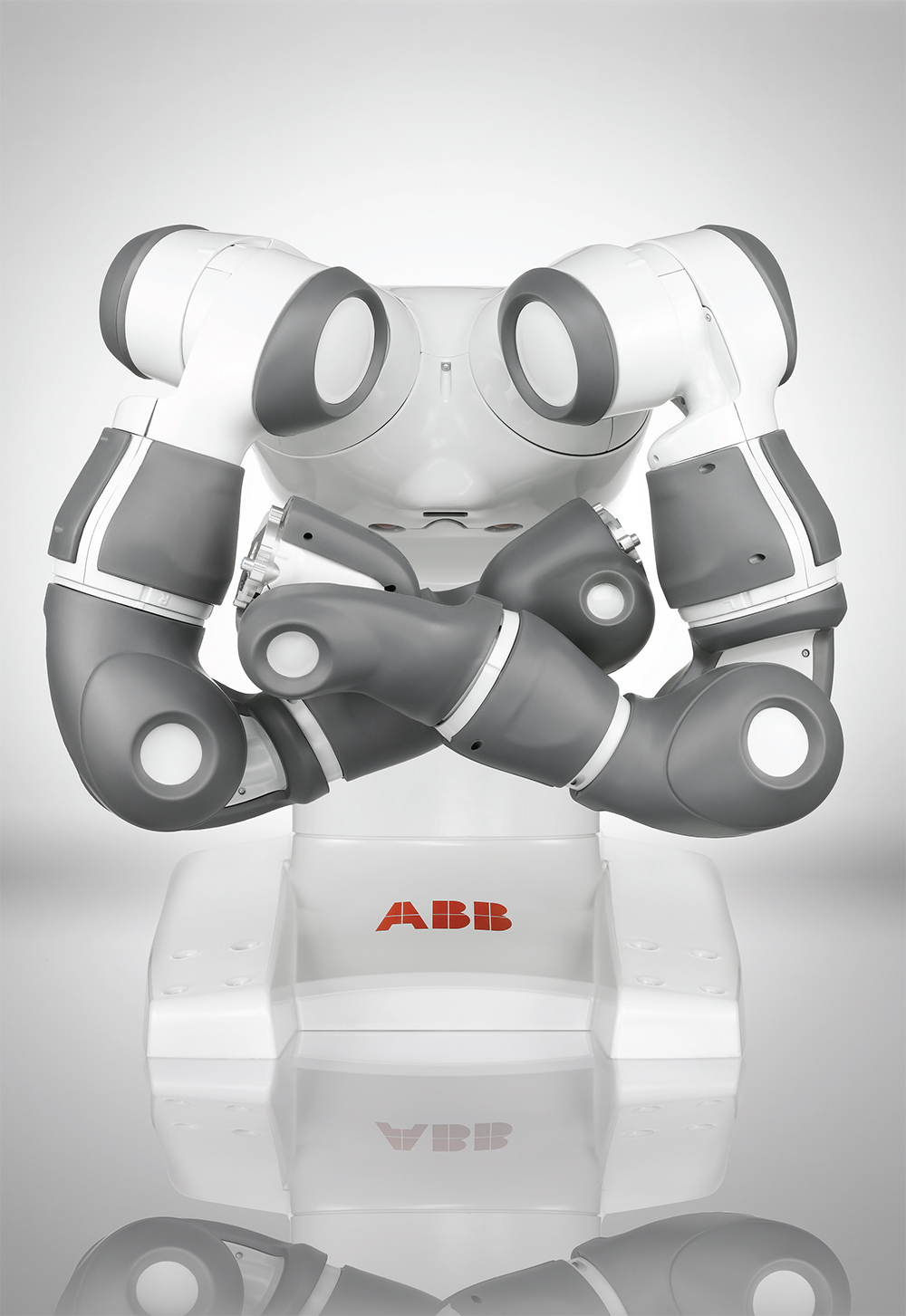 |
| |
|
|
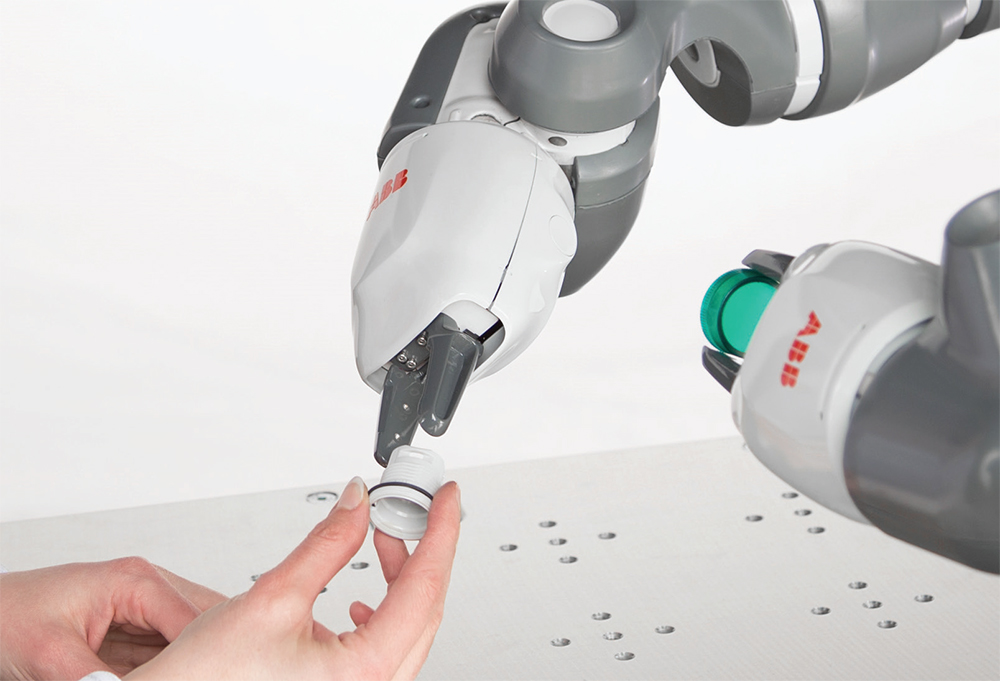 |
| |
|
|
YuMi: Creating an automated future together
With the introduction of YuMi, the world’s first truly collaborative
dual-arm industrial robot, ABB Robotics is once again pushing
the boundaries of what robotic automation will look like in the
future and how it will fundamentally alter the types of industrial
processes that can be automated with robots. A play on words,
YuMi signifies “you” and “me” creating an automated future
together. This groundbreaking solution is the result of years
of research and development, heralding a new era of robotic
coworkers that are able to work side-by-side on the same tasks
as humans while still ensuring the safety of those around it.
Few production arenas are changing as quickly as small parts
assembly. The electronics industry, in particular, has seen
demand skyrocket past the supply of skilled labor. As conventional
assembly methods diminish in value, manufacturers are
finding it strategically and economically imperative to invest in
new solutions.
While YuMi was specifically designed to meet the flexible and
agile production needs required in the consumer electronics
industry, it has equal application in any small parts assembly
environment thanks to its dual arms, flexible hands, universal
parts feeding system, camera-based part location, lead-through
programming, and state-of-the-art precise motion control.
At first glance, processes on manual assembly lines might
seem relatively simple to automate, but in reality it is not so
easy to replicate human abilities—we are amazing machines.
We have touch and motor control which allows us to handle
delicate things with dexterity and precision, as well as judge
how much force to use on a given component so that we do not break it. We can see where an item is, easily pick it up,
and are able to handle an incredibly diverse variety of parts
without pausing. We also have spatial awareness which allows
us to interact closely and in harmony with our coworkers. |
|
With YuMi, the challenge was to determine how to replicate
all of these human attributes in a way that was cost-effectiveessentially
recreating the minimum number of senses and
abilities necessary to be at least as safe as humans, yet still
able to provide the substantial benefits of automation. Thr ough
purpose-built design that is much more than just the robot, we
have created an inherently safe system of components that
delivers the precision, ease-of-use, speed, flexibility and r eturnon-
investment required for the future of small parts assembly.
At its core, YuMi has the DNA of safety. Much like a human
arm has a skeleton covered with muscles that provide padding,
YuMi has a lightweight yet rigid magnesium skeleton covered
with a floating plastic casing wrapped in soft padding. This
arrangement absorbs the force of any unexpected impacts to
a very high degree. Like the human arm, YuMi has no pinch
points so that sensitive ancillary parts cannot be crushed between
two opposing surfaces as the axes open and close.
YuMi is compact, with dimensions similar to that of a human,
and dual-arms featuring seven axes of movement each allow
the robot to have greater dexterity and precision inside a compact,
human-sized workspace. YuMi only weighs 35 kg, has
an integrated control system, integrated internal cabling for a
multitude of input and output commands including air and digital,
works off of standard household electrical power found the
world over, and is extremely portable and re-deployable at will. |
| |
|
|
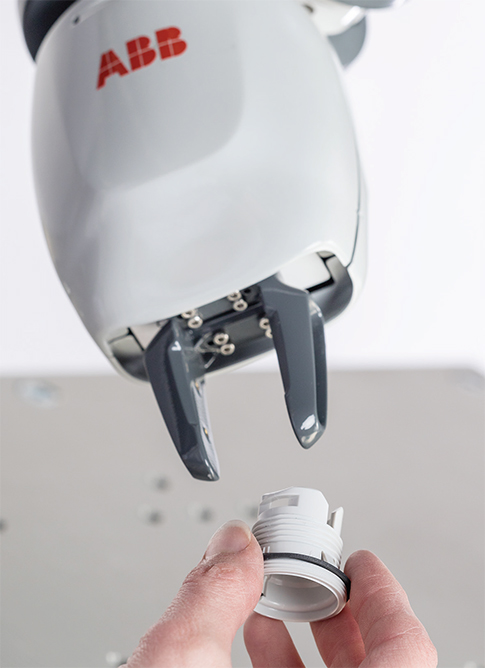 |
|
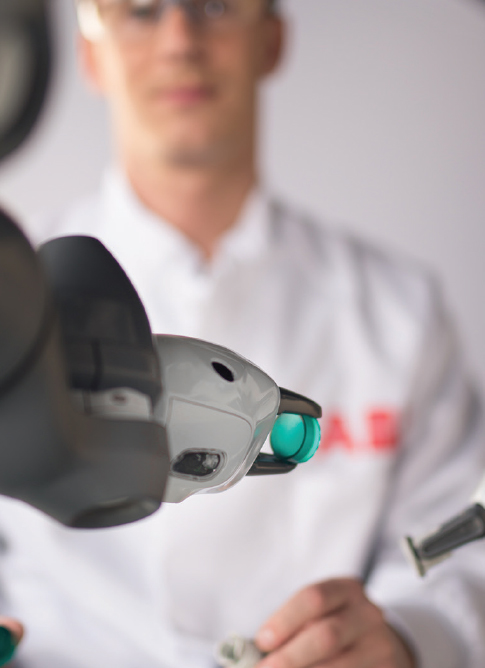 |
| |
|
|
If YuMi senses an unexpected impact, such as a collision with
a coworker, it can pause its motion within milliseconds, and
the motion can be restarted again as easily as pressing play
on a remote control. When this is combined with the floating
padding, safety for a human coworker is drastically increased.
Even with these inherent safety features, YuMi is incredibly
precise and fast, returning to the same point in space over
and over again to within 0.02 mm accuracy and moving at a
maximum velocity of 1,500 mm/sec.
To handle the great variety of parts that are seen in today’s
small parts assembly environments, YuMi comes with integrated
and highly flexible hands which can be deployed in a variety
of configurations, including servo grippers, dual suction
cups, and vision. Altogether, YuMi’s hands allow for complete
customization to meet the demands of most assembly tasks.
However, the complex operational problems found in small
parts assembly do not simply revolve around the flexibility of
human hands; supplying the parts for a given task is also key
to efficient operation. To address this we developed the Flex-
Feeder™ system for parts delivery. The FlexFeeder stores a
large number of parts, ranging from 3 mm to 30 mm in size, in
a bin. Picking parts directly from the bin is a very complicated
three-dimensional problem, so the FlexFeeder turns this into
a much easier two-dimensional picking operation by serving
those parts from the bin in small numbers up onto a flat surface.
From this flat surface YuMi’s integrated hand cameras
can easily locate and then direct the grippers to pick parts. |
|
Finally, to make programming YuMi as simple as telling a
human what to do, we have created a programming system
so easy anyone can use it. In fact, we hesitate to even call it
programming. It is more like teaching—and everyone intuitively
knows how to teach. Simply guide YuMi’s arms and
hands, using your own arms and hands, through a series
of movements, logging waypoints and gripper actions on a
paired tablet running the YuMi app. Watch as the software
turns those movements into the underlying code that makes
YuMi work—right in front of your eyes and in real-time. This
means that YuMi requires far fewer engineering resources to
accomplish very complicated tasks.
Lead-Through Programming can turn what used to be hours of
tedious programming into a few minutes of easy work. When
the tasks are more complicated than Lead-Through Programming
allows, full access to traditional coding using ABB’s
RAPID programming language is still there when you need it.
Why YuMi is important to the world
If we take all the features and innovations encompassed in
this product, we are not just providing a robot, we are providing
a complete solution for the automation of small parts assembly.
For the manufacturers who employ YuMi, the benefits
will be undeniable in terms of faster production, higher quality
products, lower waste, greater efficiency, increased flexibility
and incredible return on investment—but YuMi is much more
than an economic growth stimulator.
If we analyze YuMi through the lens of ABB’s vision of “Power
and Productivity for a Better W orld,” YuMi clearly addresses
the productivity portion. It also helps create a better world by
providing a strong means to decouple economic growth from
both environmental and human impact. |
| |
|
|
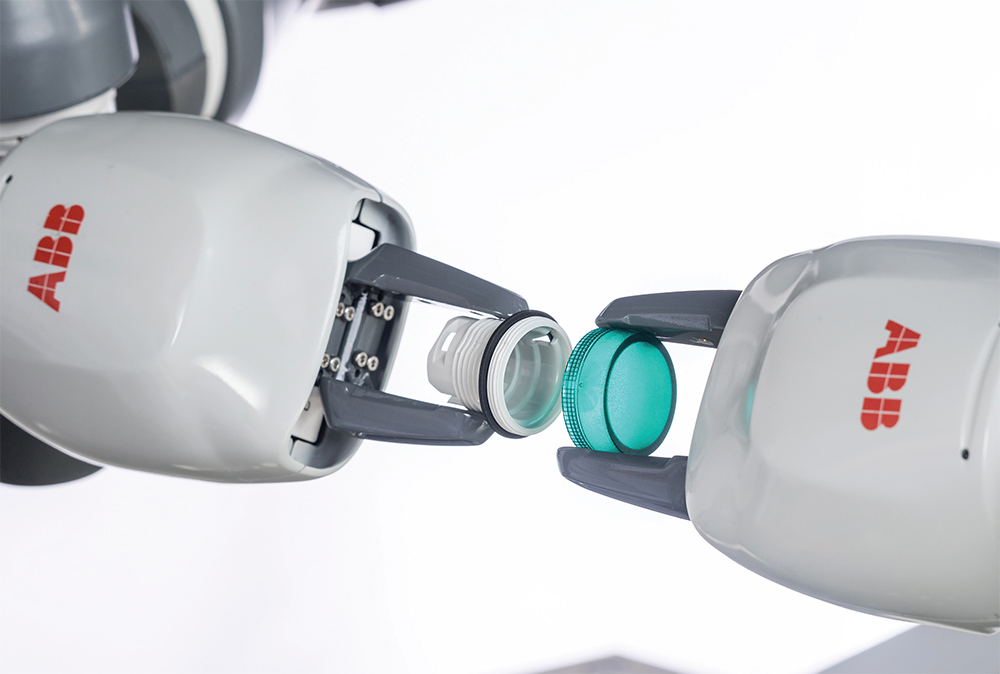 |
| |
|
|
As a complete solution, YuMi not only benefits the manufacturer,
it benefits the entire value chain, from the manufacturer
to the worker, to the environment, to the consumer of the
product. It is better for the worker because it provides a safer
working environment and a higher quality of life. It is better
for the environment because it has lower inputs and results in
less waste. Ultimately, it is better for the consumer because
when humans and robots work together, it often results in
surpassing the precision and speed of human-only work,
resulting in higher quality products and less waste.
Benefits of human-robot collaboration into the future
While YuMi is specifically designed for small parts assembly,
and has significant benefits in its own right, it is only the first
solution from ABB designed with a new era of human-robot
collaboration in mind. The benefits of collaboration clearly are
not limited to a single industry; in fact, almost any industry
stands to reap the benefits of collaborative robotic solutions.
Firstly, collaboration allows for the automation of processes
which still require humans to be part of the solution and cannot
be fully automated with existing technology. This opens
up entirely new and untapped markets to automation.
Secondly, while conventional robotic systems will still be needed
for a long time to come and have several key advantages
over current collaborative technology (e.g. higher payloads,
much faster cycle times and stronger protection from harsh
environments such as foundries), collaborative robots are far
less resource-intensive in terms of system design, installation,
commissioning and operation when compared to conventional
industrial robots. In fact, many conventional robotic systems |
|
have already realized some of these benefits thanks to advances
in software and hardware safety control, like ABB’s SafeMove
technology combined with different kinds of vision and environmental
monitoring systems making them “partially” collaborative.
In particular, fully collaborative automation without safety
restrictions and in compact spaces makes for easier factory
installation utilizing existing footprints. Programming in the
collaborative environment can also be done by “teaching”
the robot rather than using a coding language. While system
operators can always use ABB’s powerful underlying RAPID
programming language if they choose, the ability to interact
with the robot while moving it around and training it how to
get from point A to point B means that many new tasks can
be trained in a matter of minutes as opposed to hours. Altogether,
ABB’s collaboration system of components, including
the robot, makes for much simpler integration of robotic
automation.
Thirdly, collaborative robots elevate the nature of work by
allowing people to do the jobs that require more thought and
are less physically demanding. In addition, when humans and
robots work together, it often results in surpassing the precision
and speed of human-only work, resulting in higher quality
products and less waste.
As demographics change around the world, and standards of
living across the planet rise, people will increasingly seek the
jobs that are more mentally rewarding. To keep up with this
change, collaborative robots simultaneously make workplaces
more appealing and replace the manufacturing skills that are
disappearing from the workforce. |
| |
|
|
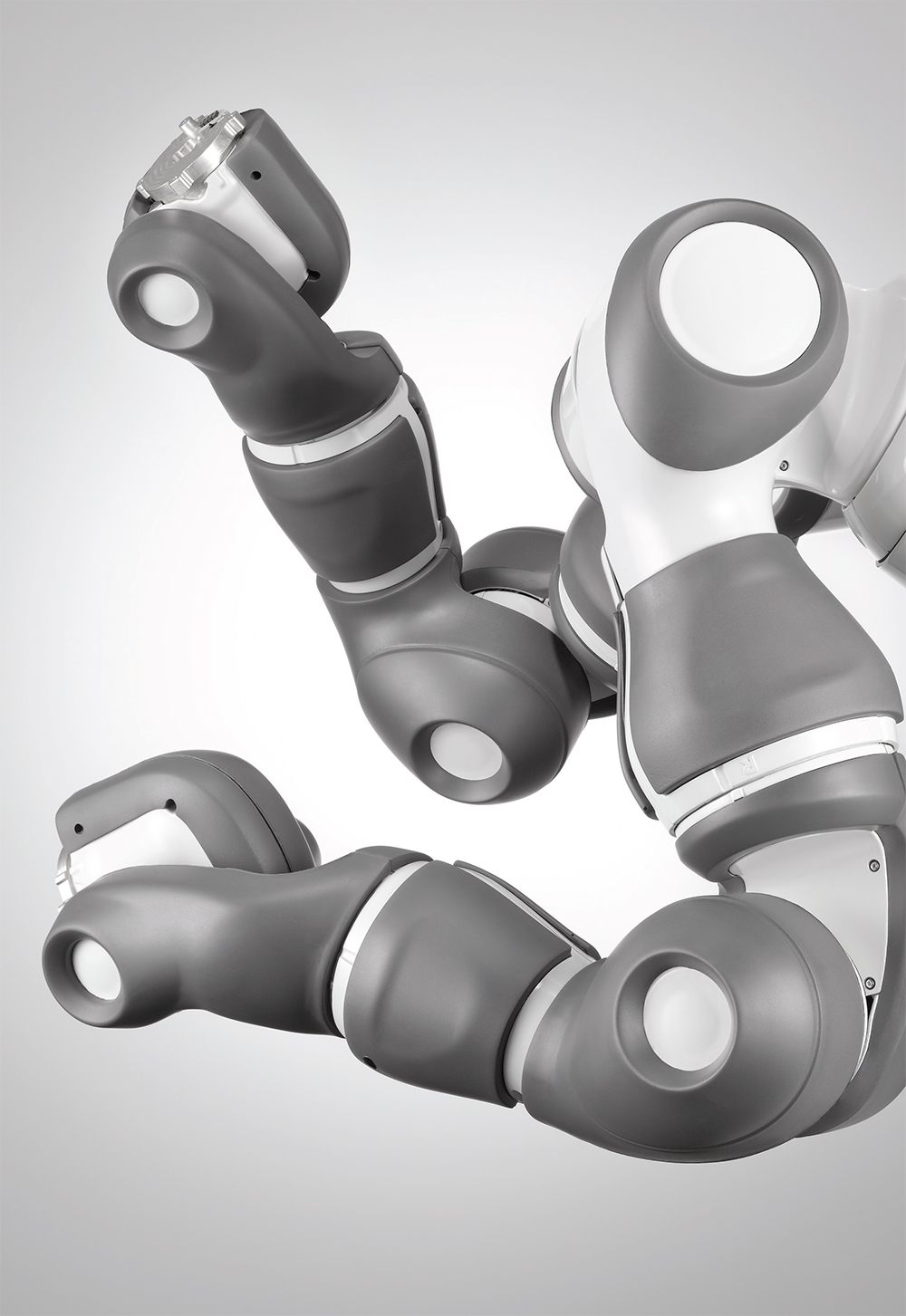 |
| |
|
|
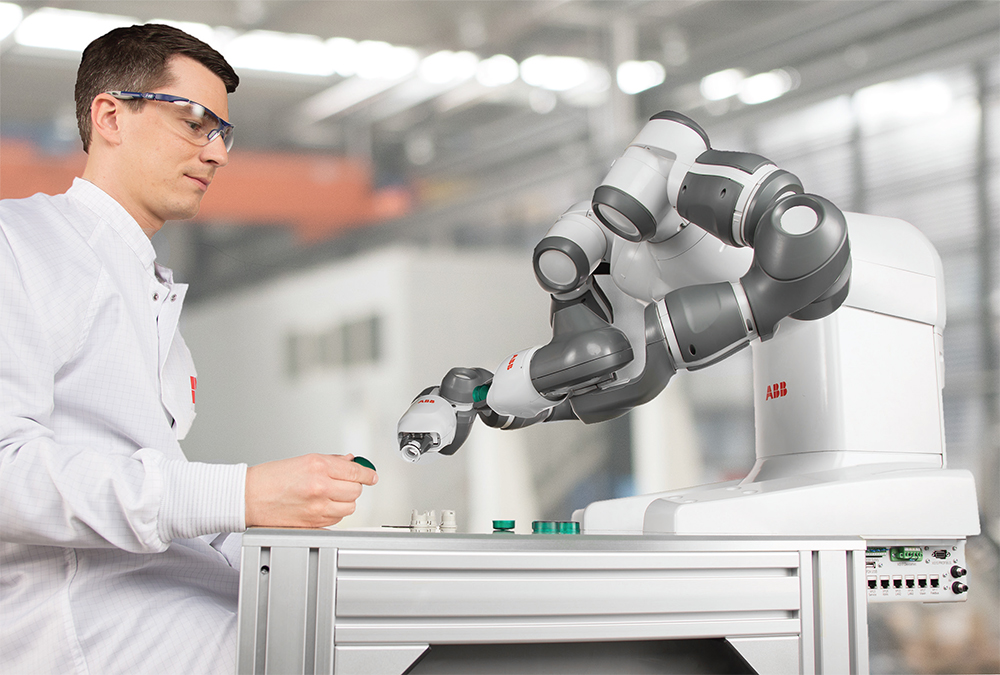 |
| |
|
|
Robots and jobs
As the robotics market continues to exhibit explosive growth,
collaborative human-robot workplaces will be a large driver
of that growth, thanks to increased ease of deployment and
operation, as well as the automation of many industries that
were previously considered impossible to automate effectively.
The topic of how this increase in robots in the workforce will
affect jobs is one that has captured much attention. ABB
believes in a more optimistic outcome from the increasing
adoption of robots and the explosion in automation as a result
of the increase in human-robot collaboration and the convergence
of other technologies. This optimism is not borne out of
a sense of idealism, but is instead rooted in the experiences
conveyed to us by history.
Every single major advance in over the past few hundred years
of industrialization has resulted in a stronger economy, not a
weaker one. It is true that after each of these advances, some
types of jobs have become unnecessary. However, many more
jobs have been created as a result of the advances, so the job
loss is only restricted to the areas that were made obsolete and
the overall effect has been that of job gr owth—most significantly
in areas that no one could have imagined before the invention
of the technology that allowed for those jobs.
The freeing up of humans from the drudgery of tasks that
should be automated will likely result in a new kind of economy
that is focused on harnessing human creativity instead of
human productivity. It is not that robots are taking humans’
jobs, it is that humans were doing the jobs robots should have
been doing for first few hundred years of industrialization— |
|
and now the technology of automation has finally caught up
to allow robots to do the jobs they are best suited for.
Certainly, the economy of the future will be drastically different
from the economy of the first few hundred years of industrialized
society. We do not know what that future will look
like, but if history is a lesson, it will likely be full of jobs that
are better suited to humans and do not cause the kinds of
workplace injuries, both physical and mental, that can exist in
today’s manufacturing environments. At ABB, we would not
be pursuing this kind of technology if we did not believe it will
result in a better world for all human beings.
Conclusion
With the rise of collaborative robots we will see a drastic
change in the way manufacturing is automated and conducted
in the future. We will also see a paradigm shift in the way humans
do work and what types of work are considered valuable.
Just like every other major advance in the history of industrialization,
the increasing automation of more and more jobs
will result in an explosion of newer and better jobs, some of
which we cannot even envision right now. ABB is dedicated to
making the world a better place, and collaborative robots are
going to be a strong part of that.
With the era of collaborative robots we recognize the fact that
humans and robots both have their own strengths, and when
working together, shoulder-to-shoulder, in a safe manner, the
workplaces of the future will be more flexible, produce better
quality products with fewer resources, provide a safer working
environment, improve employee quality of life, and make companies
more competitive. |
| |
|
|
|
|
|

